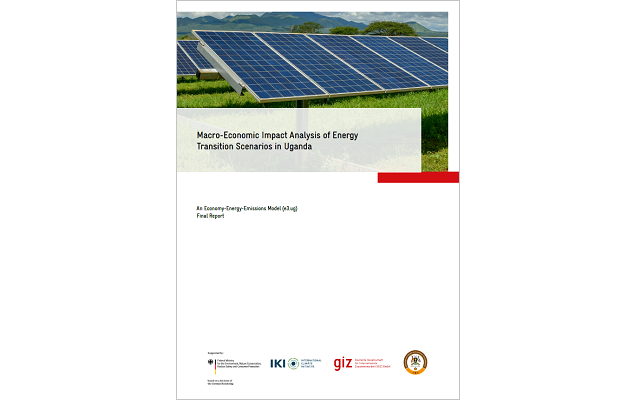Macro-Economic Impact Analysis of Energy Transition Scenarios in Uganda.
Großmann, A., Hohmann, F., Banning, M. & Dreuw. P. (2023): Macro-Economic Impact Analysis of Energy Transition Scenarios in Uganda. An Economy-Energy-Emissions Model (e3.ug). Final Report, Eschborn, Bonn.Abstract
The Ministry of Energy and Mineral Development of Uganda states in its updated energy policy that achieving the right balance between energy, economy and the environment leads to sustainable development (MEMD 2019, p. 7). As signatory to the United Nations Framework Convention on Climate Change and the Paris Agreement, this priority is reflected in the country’s climate policy as well. As per its first Nationally Determined Contributions (NDC) in 2016 and its updated NDC in 2022, Uganda aims to implement climate mitigation measures amongst others in the energy and forestry sectors (MWE 2015, 2022). Uganda strives to reach a total renewable energy capacity of at least 4,575 MW by 2040 (MWE 2015; MEMD 2022b). The mitigation potential of expanding RE capacity in the energy sector is significant, considering the possible offsetting of wood and charcoal burning and the resulting deforestation (MWE 2015).
The implementation of the envisaged “energy transition” towards electricity from renewable energy sources and energy efficiency improvements are expected to exhibit various benefits for single sectors and the whole economy which can be detected by and analysed with an environmentally extended economic model, a so-called E3 model (economy, energy, emissions). It allows for discovering not only obvious direct impacts but also impacts stemming from second round effects and feedback loops. This integrated modelling approach of the 3Es in one model framework assures a consistent view of possible transition pathways in Uganda.
Such a model – the e3.ug – was built for Uganda. It is a projection and simulation model which was developed to evaluate the macroeconomic impacts of energy policies for every year until 2050. Each of the three model parts is based on a rich and up-to-date dataset given (as far as possible) as time series on an annual basis which allows for deriving model relationships empirically. The business-as-usual (BAU) scenario extrapolates the relationships observed in the past into the future under consideration of exogenous developments retrieved from other sources such as population and oil price development. The business-as-usual scenario is not to be interpreted as a projection in terms of the most realistic development. It serves as a benchmark to compare model results of policy scenarios. Thus, a further expansion of renewable energy generation capacities is not foreseen, and energy efficiency improvements remain low in the business-asusual scenario. [...]

